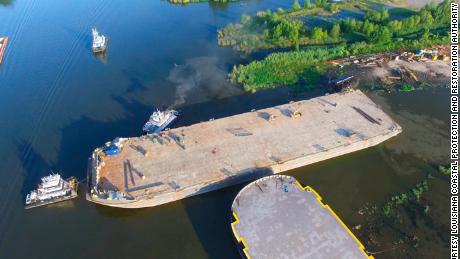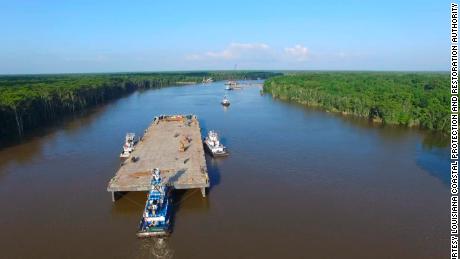Despite being near rivers that tend to cause backwater flooding, the parish had been largely spared — thanks to a 400-foot-long sunken barge in nearby Bayou Chene, according to the parish's emergency preparedness director, John Boudreaux.Hurricane Barry made landfall in the state as a Category 1 storm Saturday before being downgraded to a tropical storm. It weakened further to a tropical depression Sunday as it moved slowly north across Louisiana and into Arkansas.Communities across Louisiana braced for storm surges and major floods, especially along an already swollen Mississippi River. Even as the storm continues north, some have been concerned that water could come back downstream along the Mississippi from flooding inland.But in Assumption Parish, in towns such as Pierre Part, the scene was quiet Sunday between bands of wind and rain. Water had accumulated on lawns and roadsides — in some cases calm enough for ducks to wade across — but streets were still passable."They basically dammed off that waterway and stopped that water from coming in," Boudreaux told CNN, adding that the waters had dropped roughly two feet in the month leading up to the storm."If that wasn't done, we would've had some problems," he said. "It really saved the day." Starting in late May, the barge — longer than a standard football field — was filled with water and sunk over eight hours as part of a multi-agency effort to combat high waters from the Mississippi and Atchafalaya rivers, which can get backed up and creep north into a number of surrounding parishes. The barge was wrapped in sheet piles and rock and is secured in place with 110-foot-long pipes that are thrust into the bottom of the channel.
Starting in late May, the barge — longer than a standard football field — was filled with water and sunk over eight hours as part of a multi-agency effort to combat high waters from the Mississippi and Atchafalaya rivers, which can get backed up and creep north into a number of surrounding parishes. The barge was wrapped in sheet piles and rock and is secured in place with 110-foot-long pipes that are thrust into the bottom of the channel. This is the third time in recent years officials have sunken a barge to prevent flooding, but the practice of barge-sinking in Bayou Chene goes back as far as 1973, according to the officeRead More – Source
This is the third time in recent years officials have sunken a barge to prevent flooding, but the practice of barge-sinking in Bayou Chene goes back as far as 1973, according to the officeRead More – Source
[contf] [contfnew] 
CNN
[contfnewc] [contfnewc]






